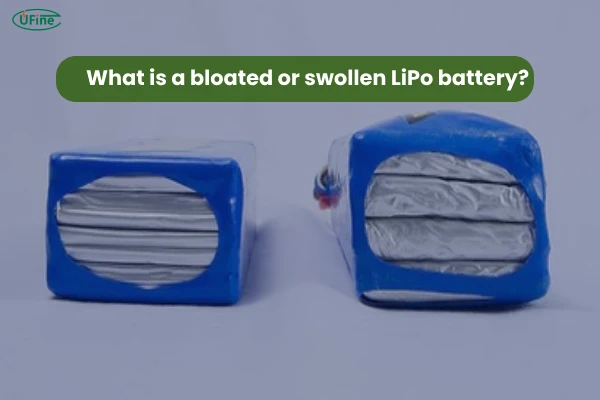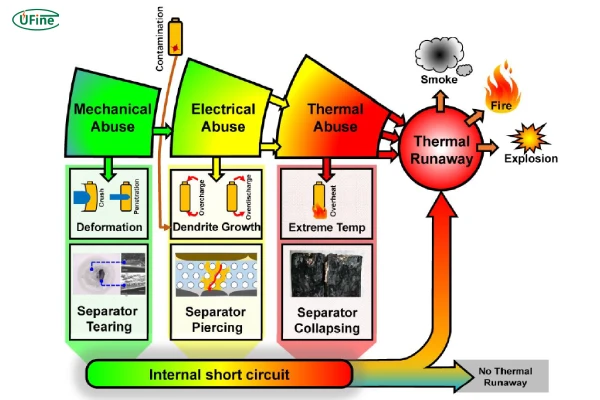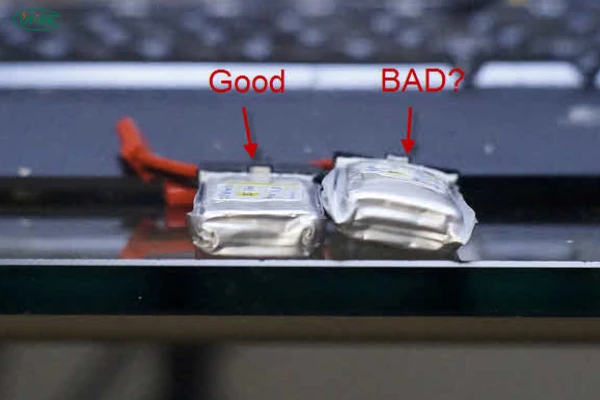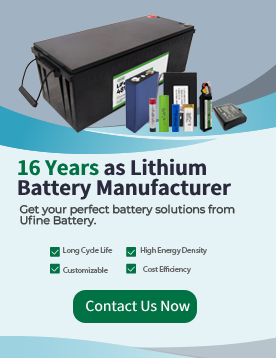Part 1. What is a bloated or swollen LiPo battery?
A swollen LiPo battery means the battery has physically expanded due to internal gas buildup. It’s a clear sign that something has gone wrong inside the battery.
This bloating happens when the internal chemical reactions inside the lithium polymer cells go unstable. Gases like carbon dioxide or hydrogen build up inside, making the soft pouch expand.
1.1 Electrochemical Processes Leading to Gas Formation
LiPo batteries swell due to gas evolution inside their sealed pouches. This occurs through several mechanisms:
A. Electrolyte Decomposition:
- At voltages above 4.2V/cell, the electrolyte (typically LiPF₆ in organic solvents) breaks down
- This produces CO₂, CO, and various hydrocarbons
- The reaction follows: LiPF₆ → LiF + PF₅ (then PF₅ + solvent → CO₂ + HF + …)
B. Lithium Plating:
- Occurs during overcharging or fast charging at low temperatures
- Metallic lithium deposits form on the anode
- Reacts with electrolyte to form Li₂CO₃ and H₂ gas
C. Moisture Contamination:
- Just 50ppm of water can trigger: H₂O + LiPF₆ → HF + POF₃ + …
- These acidic byproducts further degrade cell components
1.2 Mechanical Stress Factors
The pouch cell design makes LiPos particularly susceptible to:
- Delamination of electrode layers
- Separator shrinkage at elevated temperatures
- Current collector corrosion
These physical changes create internal voids where gas accumulates.
Part 2. Explosion mechanisms: understanding thermal runaway
2.1 The Chain Reaction Process
Thermal runaway occurs through this sequence:
- Localized heating (>80°C) melts the polyethylene separator
- Internal short circuits generate more heat
- Electrolyte vaporizes, increasing pouch pressure
- Cathode material decomposes, releasing oxygen
- Exothermic reactions accelerate uncontrollably
2.2 Energy Release Calculations
A standard 2200mAh 3S LiPo contains enough energy to:
- Heat 1 liter of water from 20°C to 80°C
- Produce over 5 liters of flammable gas
- Generate peak temperatures exceeding 800°C
Reasons and Solutions for Lithium Batteries Getting Hot When Charging
Part 3. Why do LiPo batteries swell?
LiPo batteries are sensitive. A few key things can cause swelling:
- Overcharging – Charging beyond 4.2V per cell stresses the battery and generates gas.
- Over-discharging – Running the battery below 3.0V per cell damages the internal chemistry.
- Overheating – Charging or using a LiPo in hot conditions can lead to chemical breakdown.
- Poor quality or old batteries – Cheaper LiPos with poor chemistry degrade faster.
- Puncture or damage – Even a small tear in the cell pouch can cause gas leakage and swelling.
So if your battery swells up, think back—did you overcharge it? Did you use it right after flying your drone hard in the sun?
Part 4. Will a bloated LiPo battery explode?
Here’s the big question: Will it explode?
Well… it can, but it doesn’t always.
If you keep using a swollen LiPo, or worse, charge it again, you increase the risk. The gas buildup makes the battery unstable. A spark, heat, or over-voltage can trigger thermal runaway—a chemical reaction that causes fire or explosion.
So no, not every swollen battery explodes. But it’s like keeping a balloon over a fire—it might pop, or it might burst into flames.
That’s a risk you just don’t want to take.
We’ve developed a 5-level classification system for swelling severity:
| Level | Puffiness | Internal Pressure | Recommended Action |
|---|---|---|---|
| 1 | <5% thickness increase | <5 psi | Monitor closely |
| 2 | 5-15% increase | 5-15 psi | Remove from service |
| 3 | 15-30% increase | 15-30 psi | Immediate discharge |
| 4 | 30-50% increase | 30-50 psi | Fire containment |
| 5 | >50% increase | >50 psi | Emergency protocols |
Part 5. Professional handling protocols for bloated batteries
5.1 Immediate Response Checklist
For Level 1-3 Swelling:
- Disconnect from all devices
- Place in fireproof container (LiPo bag or metal box)
- Discharge to 0V using a controlled discharger
- Prepare for proper disposal
For Level 4-5 Swelling:
- Evacuate non-essential personnel
- Don fire-resistant gloves and face shield
- Move to outdoor concrete area
- Have Class D fire extinguisher ready
- Contact hazardous materials team if available
5.2 Specialized Discharge Methods
A. Resistive Discharge:
- Use a high-wattage power resistor (10Ω, 50W for 3S)
- Monitor temperature continuously
- Discharge to <1V per cell
B. Saltwater Method:
- Prepare 5% NaCl solution
- Submerge battery for 72+ hours
- Verify 0V before disposal
Part 6. Warning signs that your LiPo battery is dangerous
If your battery shows any of these signs, stop using it immediately:
- Visible swelling or puffiness
- Heat while charging or discharging
- Strange smell (sweet or metallic)
- Leaking fluid
- Cracks or punctures in the case
- Reduced runtime or poor performance
Listen to your gut. If your battery “feels” off, it probably is.
Part 7. What to do with a swollen LiPo battery
So, what should you do with a bloated LiPo?
- Stop using it immediately.
- Do not charge it again.
- Place it in a fireproof container, like a LiPo-safe bag or metal box.
- Take it to a battery recycling center or hazardous waste facility. Never toss it in the trash.
If you’re unsure, contact the battery manufacturer for disposal instructions.
And please—don’t puncture it. That’s a recipe for fire.
Part 8. How to prevent LiPo battery swelling
Good news—you can avoid swelling with proper care.
- Always use a LiPo balance charger.
- Never charge above 4.2V per cell.
- Don’t discharge below 3.2V per cell.
- Avoid full charges for storage—store at around 3.7V–3.85V.
- Let the battery cool before charging after use.
- Store batteries in cool, dry places, ideally in LiPo-safe containers.
Part 9. Advanced prevention techniques
9.1 Charging Best Practices
Voltage Thresholds:
- Absolute maximum: 4.25V/cell
- Recommended cutoff: 4.20V/cell
- Storage voltage: 3.80-3.85V/cell
Temperature Monitoring:
- Charge only between 5°C-45°C
- Use IR thermometer to check cell temperatures
9.2 Storage Solutions
Ideal Conditions:
- Temperature: 15°C ±5°C
- Humidity: <50% RH
- Pressure: Sealed in moisture-proof bag
Ufine Battery’s Recommended Storage Charger:
- Maintains optimal storage voltage automatically
- Features cell balancing during storage
- Includes temperature compensation
A well-maintained LiPo can last hundreds of cycles without bloating.
Part 10. Can a swollen LiPo be fixed?
Sadly, no. Once a battery has bloated, it’s permanently damaged.
You might see online “tricks” to shrink the pouch or vent the gas—but these are dangerous and not recommended. The internal damage has already occurred. Using it again is just asking for trouble.
Your safest bet? Retire it.
Part 11. Safety tips
Here’s a quick checklist to stay safe:
- Always supervise charging.
- Use a fireproof bag or container.
- Don’t leave LiPos in hot cars or in direct sunlight.
- Inspect batteries before every use.
- Label and rotate your battery stock.
LiPos aren’t scary when handled right. But when ignored, they’re dangerous.
Part 11. FAQs
Can I still use a slightly swollen LiPo?
No. Any swelling is a sign of failure. Stop using it immediately.
What happens if I puncture a bloated battery?
It can catch fire or explode. Never puncture a LiPo.
Can I store a swollen LiPo safely?
Yes, in a fireproof container until it can be properly disposed of.
Why do some LiPos bloat faster than others?
Quality, charging habits, and storage conditions all play a role.
Can cold temperatures cause swelling?
Not directly, but extreme temperatures stress the chemistry and may cause damage over time.
Related Tags:
More Articles

Paper Battery vs. Flexible Battery: What’s the Difference and Which Is Better?
Paper vs. flexible batteries: learn the key differences, benefits, and which power source fits best for wearables, sensors, and smart tech.
What to Know Before Buying a Tiny LiPo Battery for Your Project
Tiny LiPo batteries are powerful and compact. Learn how to choose the right one for your project with specs, safety, and charging tips.
12V 100Ah Lithium Ion Battery Price: Full Guide
Learn about 12V 100Ah lithium-ion battery price, from cost ranges to best brands, hidden fees, and how to get the best deal. A must-read for smart buyers!
Resistance and Conductivity: What It Means for Your Lithium Batteries
Resistance and conductivity impact lithium battery performance, lifespan, and safety—learn how they work and why they matter.
What Is a Semi Solid State Battery and Why Should You Care?
Semi-solid-state batteries combine safety and high energy density, making them ideal for EVs, electronics, and future energy storage.






